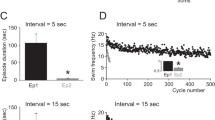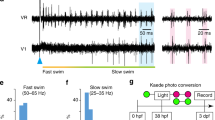Summary
1. Type 12 interneurons in pedal ganglia of Clione limacina exerted a strong influence upon the locomotor generator during “intense” swimming. These neurons generated “plateau” potentials, i.e. their membrane potential had two stable states: the “upper” one when a neuron was depolarized, and the “down” one, separated by 30–40 mV. The interneurons could remain in each state for a long time. Short depolarizing and hyperpolarizing current pulses, as well as excitatory and inhibitory postsynaptic potentials, could transfer the interneurons from one state to another. 2. When the pedal ganglia generated the locomotory rhythm, type 12 neurons received an EPSP and passed to the “upper” state in the V2-phase of a locomotor cycle. They remained at this state until the beginning of the D1-phase when they received an IPSP and passed to the “down” state. The EPSP in type 12 neurons was produced by type 8d neurons, and the IPSP by type 7 neurons. 3. Type 12 neurons exerted inhibitory influences upon many neurons active in the V1 and V2 phases, and excitatory influences upon the D-phase interneurons (type 7). 4. The functional role of type 12 neurons was to limit the activity of neurons discharging in the V-phase of a locomotory cycle. In addition, they enhanced the excitation of the D-phase neurons and promoted, thus, the transition from the V-phase to the D-phase.
Similar content being viewed by others
References
Arshavsky YuI, Beloozerova IN, Orlovsky GN, Panchin YuV, Pavlova GA (1985a) Control of locomotion in marine mollusc Clione limacina. I. Efferent activity during actual and fictitious swimming. Exp Brain Res 58: 255–262.
Arshavsky YuI, Beloozerova IN, Orlovsky GN, Panchin YuV, Pavlova GA (1985b) Control of locomotion in marine mollusc Clione limacina. II. Rhythmic neurons of pedal ganglia. Exp Brain Res 58: 263–272.
Arshavsky YuI, Beloozerova IN, Orlovsky GN, Panchin YuV, Pavlova GA (1985c) Control of locomotion in marine mollusc Clione limacina. III. On the origin of locomotory rhythm. Exp Brain Res 58: 273–284.
Arshavsky YuI, Beloozerova IN, Orlovsky GN, Pavlova GA, Panchin YuV (1984) Neurons of pedal ganglia of pteropodial mollusc controlling activity of the locomotor generator. Nejrofiziologia 16: 543–546 (in Russian).
Byzov AL, Trifonov YuA (1982) Membrane mechanisms of the activity of horizontal cells. In: Drujan BD, Laufer M (eds) Progress in clinical and biological research, Vol 113. The Spotential. Alan R Liss Inc, New York, pp 105–122.
Byzov AL, Trifonov YuA, Chailachian LM, Golubtzov KW (1977) Amplification of graded potentials in horizontal cells of the retina. Vision Res 17: 265–273.
Carew TJ, Kandel ER (1977) Inking in Aplysia californica. II. Central program for inking. J Neurophysiol 40: 708–720.
Dickinson PS, Nagy F (1983) Control of a central pattern generator by an identified modulatory interneurone in Crustacea. II. Induction and modification of plateau properties in pyloric neurons. J Exp Biol 105: 59–82.
Gola M, Selverston A (1981) Ionic requirements for bursting activity in lobster stomatogastric neurons. J Comp Physiol 145: 191–207.
Graubard K (1978) Synaptic transmission without action potentials: input-output properties of a nonspiking presynaptic neuron. J Neurophysiol 41: 1014–1025.
Kupfermann I, Kandel ER (1970) Electrophysiological properties and functional interconnections of two symmetrical neurosecretory clusters (bag cells) in abdominal ganglion of Aplysia. J Neurophysiol 33: 865–876.
Pearson KG (1979) Local neurons and local interactions. In: Schmitt FO, Worden FG (eds) The neurosciences. Fourth study program. MIT Press, Cambridge MA, pp 145–157.
Pearson KG, Fourtner CR (1975) Nonspiking interneurons in walking system of the cockroach. J Neurophysiol 38: 33–52.
Roberts A, Bush BMH (eds) (1981) Neurons without impulses. Cambridge University Press, Cambridge.
Russel DF, Hartline DK (1978) Bursting neural networks: a reexamination. Science 200: 453–456.
Schmitt FO, Dev P, Smith BH (1976) Electrotonic processing of information by brain cells. Science 193: 114–118.
Siegler MVS, Burrows M (1980) Non-spiking interneurons and local circuits. Trends Neurosci 3: 73–77.
Author information
Authors and Affiliations
Rights and permissions
About this article
Cite this article
Arshavsky, Y.I., Beloozerova, I.N., Orlovsky, G.N. et al. Control of locomotion in marine mollusc Clione limacina IV. Role of type 12 interneurons. Exp Brain Res 58, 285–293 (1985). https://doi.org/10.1007/BF00235310
Received:
Accepted:
Issue Date:
DOI: https://doi.org/10.1007/BF00235310




